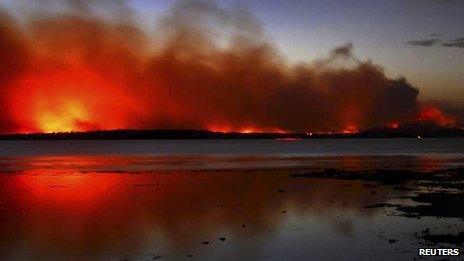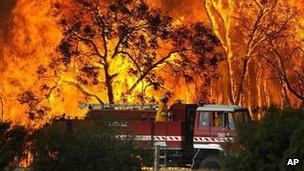Firebugs: Australia's dangerous summer arsonists
- Published

The term sounds deceptively friendly, like a character from a children's cartoon, but "firebugs" are the scourge of the southern Australian summer.
They are the arsonists who set alight bushfires, and who often strike on days when soaring temperatures and high winds combine to create the most hazardous conditions.
Facing with the ferociousness of nature can be hard enough for Australian fire crews, but in a surprisingly large number of blazes they also have to contend with the warped minds of the firebugs.
Of the 60,000 bushfires in Australia each year, 9% are lit deliberately, according to figures compiled by the Australian Institute of Criminology. Another 21% are considered suspicious.
Then there are the fires where the source of ignition is unknown, which has led researchers to believe that as many as half of all bushfires may be started deliberately.
A major blaze on Black Saturday in 2009,, external which alone killed 10 people and destroyed 150 homes, was the work of an arsonist. For setting alight what became known as the Churchill fire, Brendan Sokaluk was sentenced to 17 years in prison.
Not unusually for a "firebug", Sokaluk had once been a volunteer in the rural fire service.
The tough sentence meted out to Sokaluk, however, appears to have had little deterrent effect.
In South Australia, one of the states most prone to fire activity, the police reckon that 50 fires were started deliberately between the beginning of September and the end of December and that 60 were suspicious. And the worst of the Australian fire season usually comes in January and February.
'History of grudges'

Volunteering as firefighters lets firebugs both start blazes and put them out
Building an accurate psychological profile of firebugs has proved difficult because so few are apprehended - it is estimated that just 1% of arsonists who start bushfires are caught and convicted.
Overwhelmingly, they are male. Normally they have a history of disturbed and also fire-related behaviour. They tend to be loners, and often are unemployed.
"As children, they may have made false alarm calls to the fire service," explains Prof Katarina Fritzon, who runs the Australian Centre for Arson Research and Treatment (ACART) at Bond University in Queensland.
"They will not have completed their formal schooling, they might have been expelled from school and there's usually a history of grudges against people and disgruntlement with society."
"They're not good at social relationships," says Janet Stanley from Monash University in Melbourne, another bushfire arson expert. "They're disengaged from society and often they've had a rough trot in life." Often, firebugs are unaware of the potentially grave consequences of their actions.
Here, they differ from urban arsonists, many of whom act out of revenge against a specific target or set out to defraud insurance companies.
"Firebugs have a wider range of motivations," she says. "Sometimes it can be a cry for help. Sometimes it can be attention seeking."
Shocking as it sounds that volunteer firemen are sometimes also firebugs, it is not an unfamiliar phenomenon.
"If you've got a propensity to light fires, then you are likely to be attracted to the chaos they cause," says Janet Stanley. "It's an obvious organisation to join if you want to light fires and put them out."
Because fires are often started in secluded areas of bushland, catching arsonists in the act can be extraordinarily difficult. Even so, they often leave behind clues in the mistaken belief that the flames will incinerate all the evidence.
"They sometimes leave behind petrol cans, thinking the fire will destroy them," says Prof Fritzon, "but they don't. Fingerprints are left behind." Still, a major problem for police is that many arsonists believe they will not be apprehended.
"There's a perception that because of the remoteness, it's hard to get caught," says Prof Fritzon.
To combat the threat from firebugs, law enforcement agencies mainly rely on preventative measures. Ahead of particularly hazardous days, police visit known potential offenders to warn that they are under surveillance.
In South Australia, as part of a strategy called Operation Nomad, external, the car number plates of known arsonists are uploaded so that traffic cameras in areas prone to bushfires can alert local police. Patrols are stepped up in areas favoured by firebugs, such as the Adelaide Hills, on the edge of the state capital.
Under Operation Nomad, South Australian police have identified 278 "persons of interest", of whom 33 are considered high risk. Western Australia, under a programme called Strike Force Vulcan, has identified 36 high-risk offenders.
Despite the prevalence of firebugs, experts say that Australia does not do a good job of understanding or treating them. Complaining of a paucity of research, they note that Australia has fallen a long way behind America and Britain in this field, despite being such a fire-prone country.
There is also a lack of treatment facilities. "We haven't got a sophisticated enough mental health system," says Janet Stanley. "Arsonists tend to get imprisoned rather than treated."
So Australia is still a long way from fully understanding the minds of some of summer's most dangerous criminals.
- Published27 April 2012
- Published18 January 2013
- Published12 January 2013
- Published31 July 2010